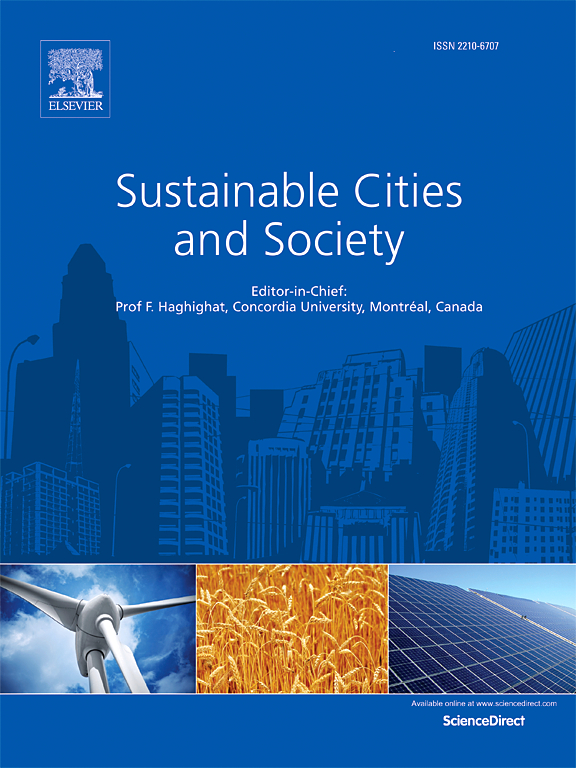Interpreting complex relationships between urban and meteorological factors and street-level urban heat islands: Application of random forest and SHAP method
IF 10.5
1区 工程技术
Q1 CONSTRUCTION & BUILDING TECHNOLOGY
引用次数: 0
Abstract
Urban and meteorological factors strongly affect street-level urban heat islands (UHIs), but few studies have considered their interactions under varying weather conditions. This study investigated the relationship between urban and meteorological factors and street-level UHI intensity in Seoul during daytime and nighttime in summer. UHI intensity was calculated from urban air temperatures measured by 568 street-level sensors. Random forest regression models and Shapley Additive exPlanations (SHAP) method were used to quantitatively analyze nonlinear relationships and interaction effects of the predictors. The results indicated that meteorological variables, particularly regional air temperature, significantly influenced UHI intensity during both daytime and nighttime. Furthermore, urban factors such as building coverage ratio and pervious ratio became more important during nighttime. Both meteorological and urban variables indicated nonlinear relationships with UHI intensity, with some showing threshold effects. Compared to total effects, main effects were significantly smaller in magnitude and range due to high parameter interactions among variables. For most variables, the sum of interaction effects outweighed main effects. In particular, notable interaction effects were observed within each meteorological and urban category. These results pinpoint that effects of urban variables are important individually and in combination with other variables. The findings highlight the importance of designing effective mitigation strategies that account for both nonlinear relationships of individual factors influencing UHI and interactive influences of multiple factors.
城市气象因子与街道热岛复杂关系的解释:随机森林和SHAP方法的应用
城市和气象因素强烈影响街道热岛(UHIs),但很少有研究考虑它们在不同天气条件下的相互作用。本研究探讨了首尔市夏季白天和夜间街道热岛强度与城市和气象因素的关系。城市热岛强度是根据568个街道传感器测量的城市空气温度计算出来的。采用随机森林回归模型和Shapley加性解释(SHAP)方法定量分析预测因子的非线性关系和交互效应。结果表明,气象变量尤其是区域气温对白天和夜间热岛强度均有显著影响。此外,建筑物覆盖率和透水率等城市因素在夜间变得更加重要。气象变量和城市变量均与热岛强度呈非线性关系,部分变量表现出阈值效应。与总效应相比,由于变量之间的高参数相互作用,主效应的幅度和范围明显较小。对于大多数变量,交互效应的总和大于主效应。特别是,在每个气象和城市类别中观察到显著的相互作用效应。这些结果指出,城市变量的影响是重要的单独和与其他变量的组合。研究结果强调了设计有效缓解战略的重要性,这些战略既要考虑影响城市热岛的个别因素之间的非线性关系,也要考虑多种因素之间的相互影响。
本文章由计算机程序翻译,如有差异,请以英文原文为准。
求助全文
约1分钟内获得全文
求助全文
来源期刊

Sustainable Cities and Society
Social Sciences-Geography, Planning and Development
CiteScore
22.00
自引率
13.70%
发文量
810
审稿时长
27 days
期刊介绍:
Sustainable Cities and Society (SCS) is an international journal that focuses on fundamental and applied research to promote environmentally sustainable and socially resilient cities. The journal welcomes cross-cutting, multi-disciplinary research in various areas, including:
1. Smart cities and resilient environments;
2. Alternative/clean energy sources, energy distribution, distributed energy generation, and energy demand reduction/management;
3. Monitoring and improving air quality in built environment and cities (e.g., healthy built environment and air quality management);
4. Energy efficient, low/zero carbon, and green buildings/communities;
5. Climate change mitigation and adaptation in urban environments;
6. Green infrastructure and BMPs;
7. Environmental Footprint accounting and management;
8. Urban agriculture and forestry;
9. ICT, smart grid and intelligent infrastructure;
10. Urban design/planning, regulations, legislation, certification, economics, and policy;
11. Social aspects, impacts and resiliency of cities;
12. Behavior monitoring, analysis and change within urban communities;
13. Health monitoring and improvement;
14. Nexus issues related to sustainable cities and societies;
15. Smart city governance;
16. Decision Support Systems for trade-off and uncertainty analysis for improved management of cities and society;
17. Big data, machine learning, and artificial intelligence applications and case studies;
18. Critical infrastructure protection, including security, privacy, forensics, and reliability issues of cyber-physical systems.
19. Water footprint reduction and urban water distribution, harvesting, treatment, reuse and management;
20. Waste reduction and recycling;
21. Wastewater collection, treatment and recycling;
22. Smart, clean and healthy transportation systems and infrastructure;
 求助内容:
求助内容: 应助结果提醒方式:
应助结果提醒方式:


